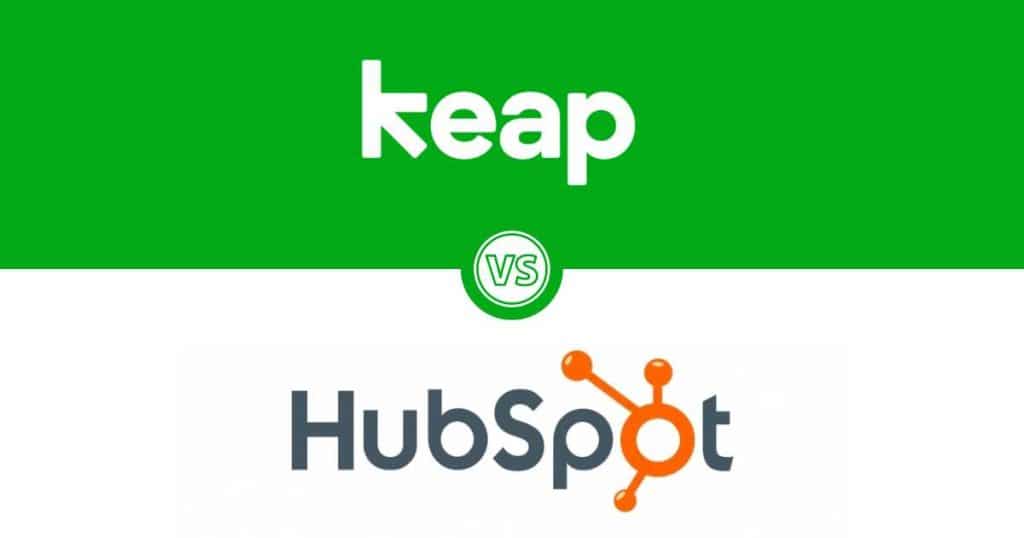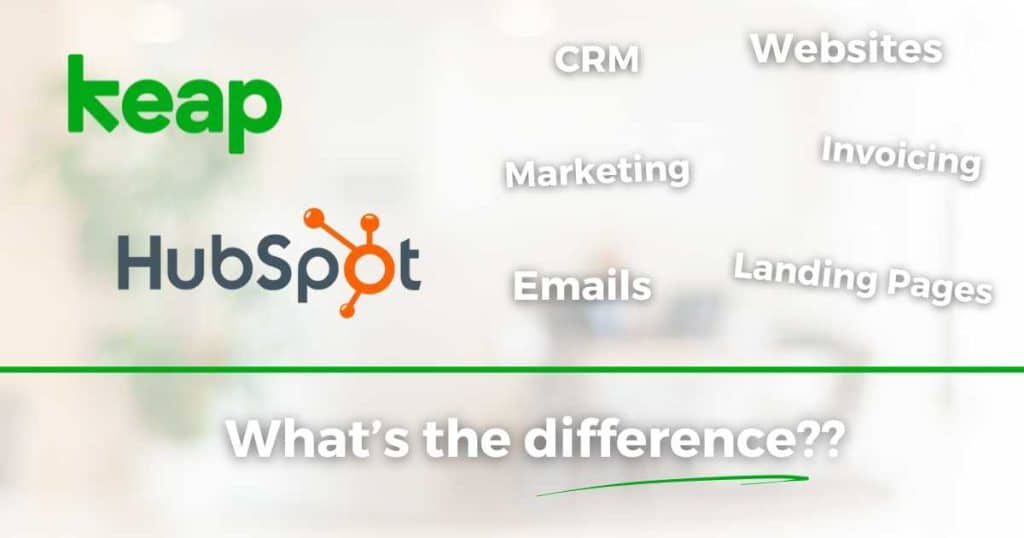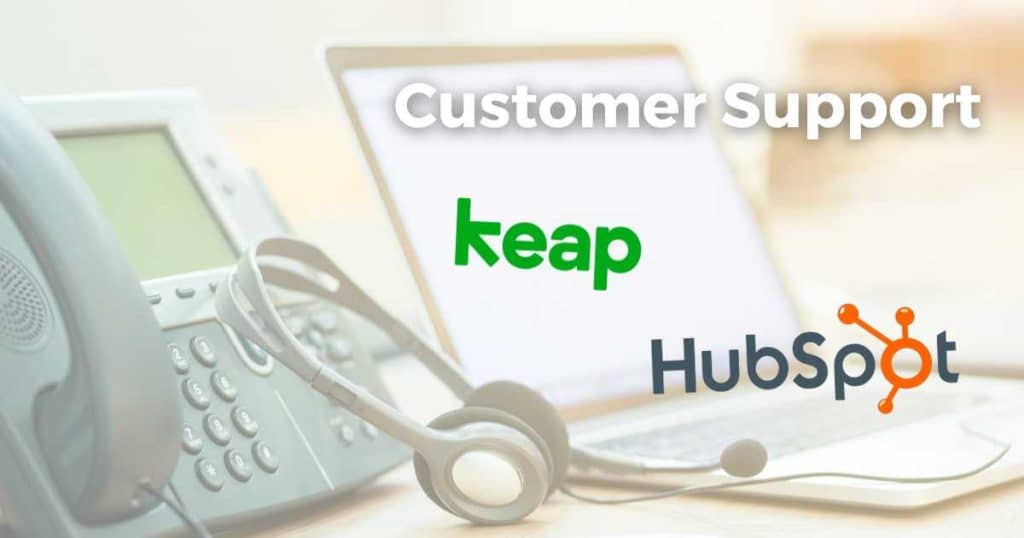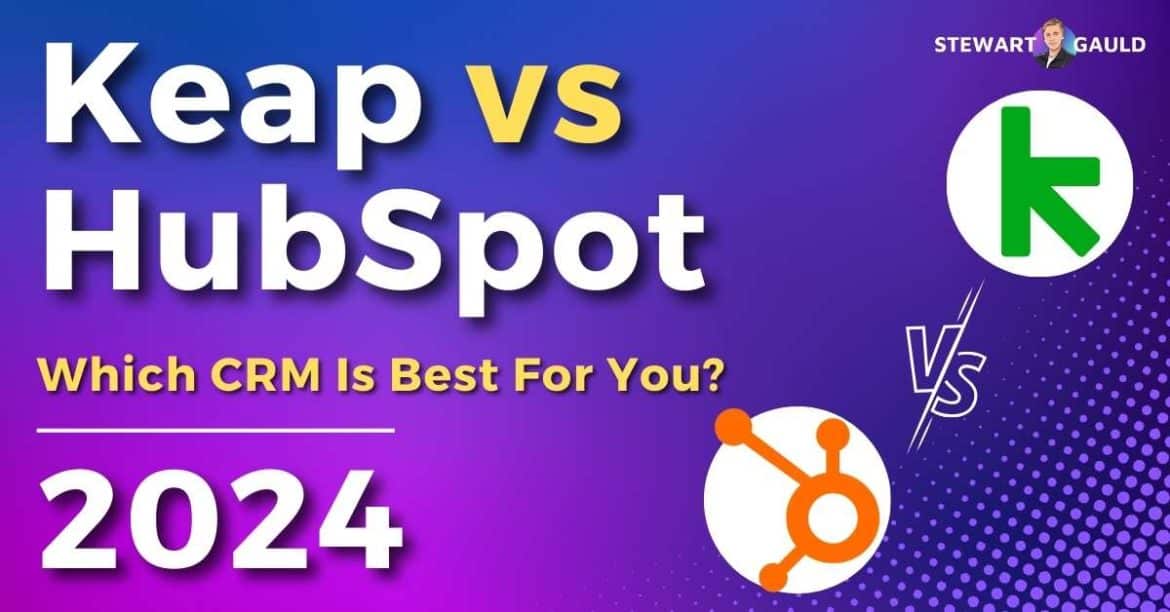Keap vs HubSpot – which is the better CRM platform for your small business?
Do you need help putting marketing and sales systems in place? Or maybe you just want to boost your network, drive sales, and deliver exceptional customer experiences?
No matter the reason, CRM (customer relationship management) solutions like Keap and HubSpot are here to save the day!
Read more: 7 Best CRM For Small Business.
Quick Summary
- Keap and HubSpot are two leading sales CRM and marketing solutions that are easy to use and benefit small business owners.
- Keap offers fewer and more basic features and is geared primarily toward small businesses. In contrast, HubSpot is a comprehensive solution for any business size or type looking to grow.
- HubSpot has an impressive free plan, while Keap only has paid plans. However, HubSpot’s separate pricing packages can be confusing and expensive for large teams.
Keap vs HubSpot 2024

You’ve probably heard of HubSpot, a leading CRM and sales marketing tool.
But did you know that Keap also offers many of the dynamic CRM and automation tools that HubSpot brings to the table?
So, does Keap stand a chance against HubSpot, or does HubSpot still reign supreme?
Keap vs HubSpot – the ultimate CRM showdown begins!
Read more: 6 Best HubSpot Alternatives.
What Are They? Keap vs HubSpot
Keap, (formerly InfusionSoft) is an all-in-one sales and marketing automation tool aimed at helping small businesses streamline daily tasks and grow sales.
Simply gain new leads through email marketing, nurture those leads with dynamic automation features, and keep on top of your customers through their intuitive CRM.
Additionally, Keap’s awesome invoicing and payment tracking tools allow you to ensure your finances are running smoothly at all times!
In contrast, HubSpot is more of a total business marketing suite, offering a wide range of marketing automation, sales, social media, and customer service and support features.
You can build websites, organize your contacts, leads, and deals, engage in email marketing, task management, book meetings, and more with Hubspot!
Keap is often referred to as a Hubspot alternative, but both platforms are actually suitable for different business needs.
By comparing and understanding the key differences between Keap vs HubSpot, you can select the option that best aligns with your business and brand!
So, what are the main differences between these two CRM and sales marketing tools?
Read more: How To Use HubSpot CRM.
What Are The Differences Between Keap vs HubSpot?

The main difference between HubSpot vs Keap lies in their plans and packages.
Keap offers all its CRM, sales, and marketing tools within one complete package.
On one hand, this means you can easily access everything you need in a single package (with the option to upgrade to a premium package for additional features).
On the other hand, HubSpot’s modular approach offers separate packages for sales, marketing, and service needs.
This flexibility allows you to choose specific modules based on your business needs.
Additionally, you could go for the Hubspot CRM Suite, a comprehensive CRM package with a pinch of marketing, sales, service, and CMS capabilities.
And if that wasn’t enough, you have the freedom to create your own customized HubSpot bundle!
Some people love this flexibility; however, it can be confusing for new users to figure out which bundle they require.
With that said, let’s dive into specifics in this Keap vs HubSpot battle!
Read more: HubSpot vs Monday.com.
Ease Of Use
The good news is that both tools are renowned for their user-friendly interfaces (one of the reasons why they’re so popular!)
Keap’s dashboard and interface (similar to Pipedrive’s) are intuitive, modern, and sleek, providing everything you need on a handy left-hand sidebar.
Additionally, the ‘Getting Started’ tab is helpful for complete CRM newbies and explains how to import and organize contacts, integrate third-party apps, and more.
Despite the abundance of tools HubSpot offers, everything can be found on one easy-to-use platform, and setting up an account on HubSpot is also quick and easy.
Many users praise HubSpot for being simple and beginner-friendly!
So, who comes out on top?
While it is undoubtedly a close contest, Keap has a slight advantage here with its straightforward and uncomplicated approach.
Winner = Keap.
Read more: Keap vs Pipedrive
Pricing
Keap:
As mentioned, Keap has a simple tiered plan structure that includes CRM, sales, marketing, and automation features:
- Pro: $159 per month (1500 contacts and 2 users).
- Max: $229 per month (2500 contacts and 3 users).
- Ultimate: $279 per month (2500 contacts and 3 users).
Additional users are $29 per user for all plans, and you can add a text marketing add-on from $9 per month.
HubSpot:
HubSpot’s dedicated CMS, sales, marketing, and operations (each with different pricing tiers) can initially seem overwhelming, so let’s simplify things.
In a nutshell, the free plan is the way to go for small teams!
It provides impressive features, including 1,000,000 contacts, unlimited users, and access to limitless customer data.
If you’re willing to invest a bit more, go with the ‘CRM Suite’ plan, which bundles all the essential tools for marketing, sales, CMS, service, and operations together.
The CRM Suite plan pricing structure is as follows:
- Free: $0
- Starter: From $18 per month
- Professional: $1600 per month.
Or, you can simply customize your own bundle – the options are limitless!
Winner = Keap.
Read more: How To Setup HubSpot CRM.
Keap vs HubSpot Key Features

Customization
With Keap, you can easily build custom and additional fields for your contacts and company records.
When compared with HubSpot, Keap’s pipeline management shines. You can drag and drop deals along the sales process and visualize your entire pipeline using a Kanban Board.
And I love that you can immediately access automations directly from each deal’s card!
With HubSpot, the level of customization is impressive – you can personalize all aspects of your account, from deals, contacts, quotes, and products.
And customizing reports and forecasting is also possible to gain better insights into your business!
Basically, if you don’t like the look of the pre-built reports, you have the flexibility to create your own using the report builder.
However, if you need to create a custom object specific to your business needs, you must upgrade to the very pricey ‘Enterprise plan’ ($5,000 per month).
In terms of customization, HubSpot offers greater flexibility compared to Keap – another win for HubSpot!
Winner = HubSpot.
Read more: HubSpot AI Content Assistant Review.
CRM and Sales Management
You’re here because you want a CRM that will make organizing and managing your contacts, leads, and deals easy, right?
Well, Keap’s contact management dashboard provides valuable features like lists, filters, and saved searches to manage your contacts effectively!
Simply tag and segment your contacts and set up triggers within your pipeline to keep on top of your contacts and deals.
Keap offers pipeline tracking, appointment scheduling, calendar integration, and the ability to create quotes and invoices to help streamline your sales processes.
Plus, you can also set up online payments, use shopping carts, and create promotions to drive sales.
In HubSpot, the CRM Suite plans include a combination of sales, service, and marketing features such as:
- Sales pipelines.
- Live chat.
- Meeting scheduling.
- Lead tracking.
- List segmentation.
- Email and call tracking.
- Document manager, and more.
And if you opt for a paid plan, you can set up triggers for when deal stages change, add deal tags, and enable email tracking notifications.
I think both platforms do a pretty good job in terms of CRM features. Therefore, I’m calling this one a tie!
Winner = Draw.
Read more: How To Create A Sales Pipeline With HubSpot.
Automation
Automation workflows are essential for improving team productivity and streamlining sales processes.
And let me tell you, both HubSpot and Keap are big players in the automation game!
Keap offers two modes of automation: easy automations and advanced automations.
- Easy automations are triggered when specific conditions have been met, for example, when an invoice has been paid or sent, when someone purchases a product, or when a deal enters a new stage. Once these conditions have been triggered, you can set ‘events,’ such as creating a deal, creating a task for the contact, or sending an email.
Automations can be built from scratch through the automations builder, or you can use their intuitive automation workflow templates to help you.
- Advanced automations in Keap allow you to create automations based on specific conditions. This could be clicking a link in an email, opening an email, submitting a form, moving a pipeline stage, or completing a task.
In comparison, HubSpot provides two primary automation features: sequences and workflows.
- Sequences are steps to complete specific tasks, like nurturing leads or following up on deals.
- Workflows automate manual and time-consuming activities like lead nurturing, updating lifecycle stages, and handing off leads to sales.
HubSpot offers seven types of triggers that can kick off a workflow, including contact-based, company-based, deal-based, and more – that’s pretty impressive!
Overall, Keap puts up a good fight. However, the options for automation in HubSpot are more extensive.
Winner = HubSpot.
Read more: 5 Ways To Optimize Your Website For Lead Generation.
Marketing
As mentioned, Keap and HubSpot offer powerful marketing tools to complement their sales CRM.
Keap combines its sales and marketing tools into one platform, which is convenient and efficient! Plus, you can set up forms or landing pages to capture leads from your website.
The platform also provides email marketing tools with templates and an open click-rate tracker to measure the success of your email campaigns.
Additionally, you can run text message broadcasts (at an additional price) and leverage marketing automation to personalize your outreach efforts.
However, HubSpot’s CRM and marketing hub takes your marketing efforts to the next level.
The platform offers a landing page builder and form creation tool, allowing you to capture leads effectively, and a handy live chat feature to enable real-time interactions with prospects.
Additionally, you can create blog posts, track your ads, manage social media accounts, run A/B test emails, and more.
As a comprehensive marketing automation software, you can easily manage personalized email campaigns, including automated follow-up emails with HubSpot.
Winner = HubSpot.
Read more: HubSpot vs ActiveCampaign.
Keap vs HubSpot Customer Support

Let’s face it: Even experienced technical gurus need help from time to time! So, who’s going to save you?
Keap and Hubspot provide live chatbots that anyone can use (whether you have an account or not!)
Keap offers support through US-based phone support, and you can even opt for a dedicated customer success manager to help you with specifics.
HubSpot’s customer support varies depending on the plan you choose.
Unfortunately, if you’re using the free CRM tools, your only support option is through the community forum (and live chat).
Starter plans offer email support, but only Professional and Enterprise members get phone support.
Overall, Keap has an edge in customer support, especially regarding accessibility and availability.
With phone and chat support available to all users, regardless of their plan, Keap’s customer support is more robust and user-friendly than HubSpot.
Winner = Keap.
Read more: HubSpot Website Builder Review.
Keap vs HubSpot Who Are They Best For?

Still not sure whether you want to choose Keap vs HubSpot for your CRM and sales marketing choice?
Well, I believe Keap is best suited for small teams looking for an all-in-one simple sales and marketing solution.
With automation features and intuitive pipeline builders designed with small business owners in mind, it’s the perfect choice for teams just starting.
On the other hand, HubSpot caters to all business types and sizes but is particularly suitable for teams looking to grow and scale their business to new heights.
If you’re after a comprehensive CRM, marketing, sales, and customer service with advanced automation capabilities, it’s worth giving HubSpot’s incredible free plan a go!
Stew’s Final Thoughts
That brings me to the end of this Keap vs HubSpot comparison post.
Personally, I use HubSpot’s free plan as a CRM for my business. However, that’s not to say that you should too!
If you don’t want all the bells and whistles that HubSpot offers, Keap is an excellent HubSpot alternative.
And at the end of the day, it all comes down to personal preference anyway!
I suggest giving HubSpot’s free plan and Keap’s 14-day free trial a go to see which you prefer.
So, Keap vs HubSpot – which CRM will you go for?

